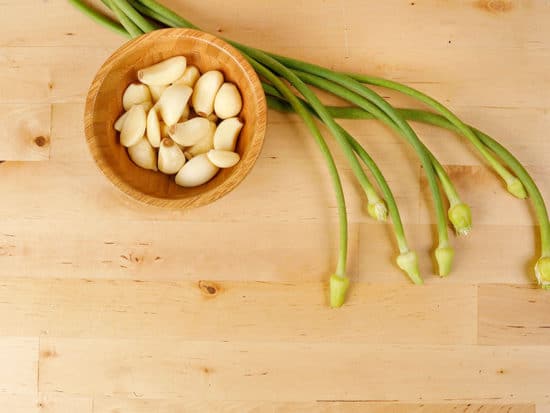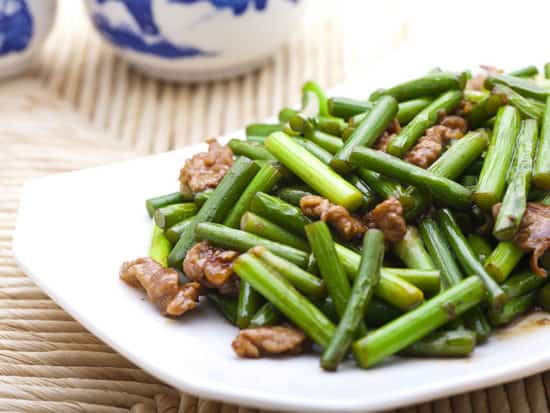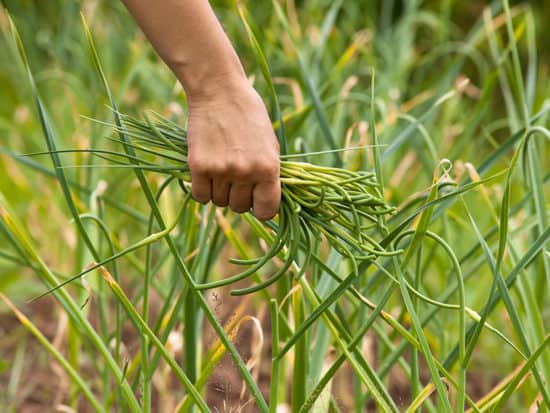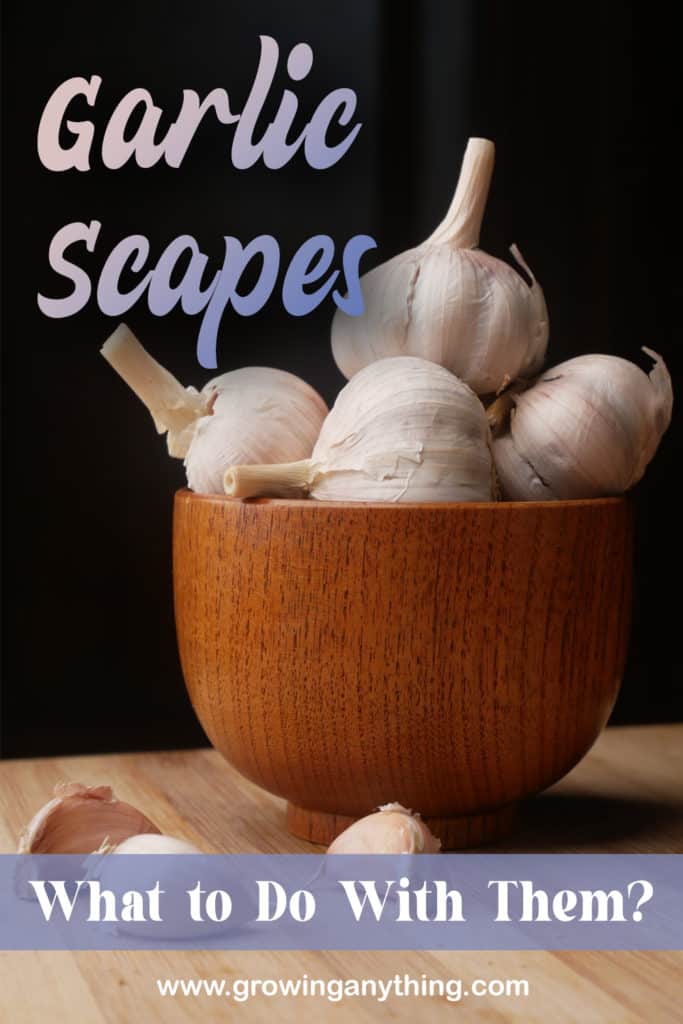What to Do With Garlic Scapes?
Many recipes include garlic as a central flavoring point, but the scapes are rare in recipes. Furthermore, garlic is an excellent choice for beginner gardeners because it is easy to grow as long as you provide optimal growing conditions. But, garlic provides two harvests, and even experienced gardeners aren’t sure what to do with the products of the first one – scapes.
I will share more tips on growing garlic generally, the importance of proper timing for harvests, and useful ideas on what to do with garlic scapes.
But, let’s briefly go through elementary information about growing garlic.
How to Grow Garlic?
Garlic is a great choice for small gardens, as this small bulbous plant doesn’t take much space. You need well-drained soil that hasn’t previously been used for plants from the onion family. It also does well in raised beds.
Planting the garlic is simple, and you should do it in mid-fall or early spring. Make sure that cloves are five inches apart and that there is one foot between rows. Put the clove inside the soil with a pointed end facing upwards. Next, push the cloves gently into the soil and water the bed. You can apply a thick mulch layer to protect the plant from frost.
Caring for Garlic
Apply one to two teaspoons of nitrogen-based, slow-decomposing fertilizer to boost the growth of your garlic.
Next, your garlic plants will produce small flower stalks with bulbils, and you should cut the stalks off.
Cutting the stalks will ensure that the garlic bulb gets as many beneficial nutrients as possible. But, what you didn’t know is that these stalks or scapes are beneficial, too.
Once you cut the stalks off, the plant will stop developing new leaves and make bulbs. You can stop watering the plant, as the garlic maintains its authentic taste for longer if the soil around the bulbs is dry.
Pests and Diseases
Garlic is simple to grow, but it is still prone to diseases. Let’s go briefly through the most common issues with garlic.
Downy Mildew
The most common is Downy mildew. It isn’t difficult to diagnose, as leaves change the color from pale to yellow and get elongated patches with their tips collapsing. The Downy mildew can attack garlic in wet soil with poor draining.
You can apply fungicides on leaves to treat the infestation. But, if it has spread across the whole plant, you will have to destroy infested plants and plant your next garlic plants somewhere else.
Purple Blotch
Fungi cause purple blotch during high-humidity periods. You can notice water-soaked lesions on foliage or stalk. Those start to grow and develop white centers and kill leaves gradually.
You can prevent the diseases by planting in well-draining soil and applying irrigation.
Besides, you can try fungicides to control the disease.
White Rot
White rot features yellow leaves and affects the growth of the plant, including scapes and bulbs. When it fully overcomes the plant, it kills entire foliage and spreads to the bulbs.
White rot can be challenging to treat as most fungicides aren’t effective against it. The safe ways to prevent it are to soak the seeds in hot water before planting, don’t transfer, and practice rotation with non-allium plants.
Bulb Mites
Bulb mites cause bulbs to rot in the ground. These are tiny pests, smaller than 1 mm in length, cream-white color.
Soaking the seeds in hot water before you plant them might help to prevent bulb mites.
Leafminers
Leafminers leave a thin trail on leaves. When the plant is under heavy attack, the leaves can have white blotches and drop from the plant.
Leafminers are small black and yellow flies that lay their eggs in the plant foliage. As the larvae develop, it feeds on leaves, destroying them slowly.
Inspect the plant for leafminers, and use insecticide.
Generally, avoid applying insecticides for no reason, as they can damage the population of natural enemies of most common garlic pests.
The First Garlic Harvest

Most gardeners who don’t use scapes further know that picking the scapes doesn’t have the right timing. Anytime is good, and you can do it when all scapes appear or now and then when you notice ones.
However, if you want to use the garlic scapes, you will benefit the most from an early harvest.
Keep an eye on your garlic plants, and cut the scapes when you notice forming flower bulbs. Ideally, you want to harvest the scapes before flowers start to bloom. Also, the scapes are curly at that time, which indicates that it is the right time for picking them. If you skip to cut them, the scapes will straighten up and lose some of their tender flavors.
The exact timing for the first garlic harvest depends on the garlic variety and growing conditions. But, if you pick the scapes in mid-June, you can expect the best flavor.
Let’s see this video to collect more understandings:
Cutting the Scapes
I recommend cutting the scapes on a warm afternoon. Therefore, the sap will dry faster. If you cut the stems in the early morning, you can drain the plant and make it prone to diseases.
It is straightforward to harvest the scapes with your fingers. All you have to do is snap the stalk above the first leaves. You can also use scissors or a knife to avoid the garlic smell sticking to your hands.
Remember, not all stalks will form at the same time, and you will probably have to visit your garlic plants a few times to complete the first harvest.
Garlic Scapes Nutritive Information
Garlic scapes are not only delicious but also healthy vegetables. They have similar properties as garlic and protect against cardiovascular diseases, arthritis, cancer, and inflammation due to high antioxidants levels.
Scapes are rich in calcium and iron, and a good source of fibers.
One cup of garlic scapes, around 136 grams contains 203 calories, but it will keep you full for longer.
You can include them in your diet as a snack or cook with other ingredients for a healthy and low-calorie dinner.
Which Garlic Varieties Produce Scapes?
Garlic has two main types, and only one of them produces scapes.
The first type that produces scapes is called stiffneck or hardneck garlic. In some areas, gardeners also call it topset garlic.
This type produces up to seven big cloves.
On the other hand, the softneck variety produces numerous smaller cloves and no scapes.
Additionally, the third type, elephant garlic, also forms scapes. But, botanically, elephant garlic isn’t garlic as it belongs to the leek family.
However, scapes of elephant garlic are considered a specific culinary delicacy. When you cut them young, they have a tender, almost sweet flavor, similar to asparagus.
You can use them in different dishes, or stir fry and dip in mayo for delicious side-dish or snack.
Top 7 Things to Do With Garlic Scapes
Once you get to know garlic scapes, you will love them and get inspired for future recipes and use. Before that happens, I will share my favorite seven ways to use garlic scapes in the kitchen.
Home-Made Pesto With Garlic Scapes
Pesto is high on the list of my favorite uses of garlic scapes. Prepare a food processor and pay attention to the order. First, you need to put fresh scapes in the process and give them a good whirl.
Next, add nuts, parmesan cheese, salt to the taste, and a bit of lemon juice. Then, whirl the ingredients again.
Lastly, add olive oil generously, and whirl your pesto again!
You can eat it fresh with pasta or put it in a jar and store it in the fridge.
Healthy Hummus
Scapes can be used in hummus preparation the same way you use regular garlic. I like them in tahini-free varieties of hummus because their tender taste is at its peak. Experiment with your famous hummus recipes, and see which combination works the best for you.
Scape Soup
Scapes are excellent when added to garlic soups. They ensure aromatic taste and change improve the color of the soup.
I recommend adding chopped scapes to your potato soup for an extra flavor twist and beautiful decoration.
Additionally, scapes taste milder than garlic. Therefore, you can use scapes as an alternative to garlic cloves in many recipes.
Grill the Scapes
You would hardly think to grill garlic and make it the highlight of the meal, but scapes are perfect for a simple, light, and healthy dinner. Grill the scapes shortly, not longer than two minutes, and add salt, pepper, olive oil. If you want to add more flavors, you can squeeze half a lemon and boost the distinct scape flavor.
You can serve them with cheese, butter, or eggs.
Using Scapes in Salads
You can use scapes similar to other vegetables blanched or stir-fried in salads. If you aren’t sure what to do with the scapes, you can prepare the scapes just like you would prepare green beans. But, expect better taste!
Side Dish for Fish
When mixed with butter, garlic scapes make a delicious side dish for grilled fish. You will need just one butter stick and one or two scapes, chopped thin. Mix them, and you use them with pan-fried fish as well!
Pizza Topping
Garlic scapes are versatile and there is a lot you can do with them. I like to cut them into smaller parts irregularly, sauté them and toss them on vegetarian pizza, for an extra kick of taste. Not only will they improve the look of your pizza, but they will provide freshness and tenderness, too!
How to Store Garlic Scapes?
There are two ways you can store garlic scapes. Both are great and preserve the scapes freshness, but the first one makes an attractive decoration, too.
Store the Scapes in a Glass of Water
You can store the scapes at room temperature in a glass of water. Make sure that the glass is long enough, so most of the scape is in the glass. Fill the glass to the top and put it on the kitchen counter.
However, remember to change the water every day, and wash the glass every other day when it becomes dirty.
This method will keep the scapes fresh for several days. If you don’t use them in four or five days, continue with method two.
Store the Scapes in Refrigerator
The scapes remain fresh in the fridge for around two weeks. Before you put them in the fridge, wash them thoroughly, as dirt may cause rotting in cold temperatures. Then, place the scapes on the clean towel and let them dry for an hour.
You can put them in a plastic bag and place them in the refrigerator with the rest of the vegetables. However, make sure that the bag is open so there is enough air circulation.
Before you use your refrigerated scapes, check if they are crisp and fresh.

Can You Pickle Garlic Scapes?
If you love pickling things, you will enjoy the unique flavor of pickled scapes.
To pickle the scapes, you have to trim both ends of the scapes and cut them to it in the jar. Mix boiling water with dill and black pepper in the jar, and add your scapes.
Mix water, vinegar, and salt and bring to the boil and then, pour the scapes gently. Make sure to leave about half an inch free in the jar. Then, close the lid, and process the jar in hot water for at least ten minutes.
Remove them from the hot bath and wait for a week until you open the yar. Once you first open the jar, your pickled scapes will be good for several weeks. But, they are delicious, so I doubt that they will last that much!
Can You Freeze Garlic Scapes?
You can freeze garlic scapes and use them year-round. First of all, make sure to wash them thoroughly to remove dirt and debris.
You can use a paper towel under scapes for excess water, and let the scapes air dry for at least an hour.
Remember washing scapes, as well as other vegetables, will remove the bacteria before freezing. If you store infested scapes, the infestation will slow down in the freezer. But, once the scapes are at warmer temperatures, the infestation will activate again.
Next, I recommend chopping the scapes and storing them in smaller bags. That way, you can use one bag at a time in different recipes. However, you can freeze them unchopped if you prefer grilling them and eating them as a snack.
One thing I learned is that chopping the tip of the scape preserves the freshness for longer.
I recommend using an airtight bag or sealed container. Ideally, you don’t want holes, and the scapes should be closed tightly without bending.
You can use your frozen scapes for up to one 1. I don’t recommend freezing them the second time. Scapes are seasonal plants, so storing and freezing them will ensure that you have access to them year-round.
If you notice a rotting or unpleasant smell from the frozen scapes, toss them immediately.
Garlic Scapes vs. Ramps
Ramps are similar to garlic scapes in appearance, but those are two different plants.
First of all, ramps are plants, and scapes are stems of garlic. Both ramps and scapes are available in spring, but ramps come earlier than scapes.
Also, ramps are sometimes called wild leeks, and their taste is similar to leeks and onions.
Sometimes, you can find ramps and scapes in the same recipes for pesto or sauces.
However, you can differentiate them by their look. Scapes look like long stems, while ramps have long, narrow leaves and a white bulb at the end.
Where to Find Garlic Scapes?
If you don’t grow the garlic in your garden, garlic scapes can be challenging to find. They are shortly available, and during the season, you can find them in Asian markets, fresh local markets, or well-supplied supermarkets.
Moreover, independent grocers and farms sometimes sell them. Therefore, once you find garlic scapes, it can be a great idea to stock them or start growing your garlic plants!

Don’t Forget to Save the Scapes!
Next time you are maintaining your garlic and cutting those stems, make sure not to toss them. Instead of using them for compost, you can prepare delicious meals with garlic scapes.
Scapes have a short season and are usually available in mid-June. Luckily, you can store them in the fridge, pickle or freeze them, and have them year-round.
You can use them for pesto, soups, salads, or even as pizza toppings. On top of everything, garlic scapes are healthy too and can be an alternative for garlic in many recipes.
Have you ever tried garlic scapes? How do you prefer them, raw or pickled?

